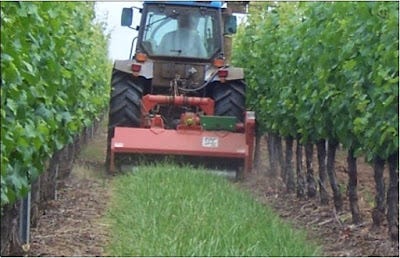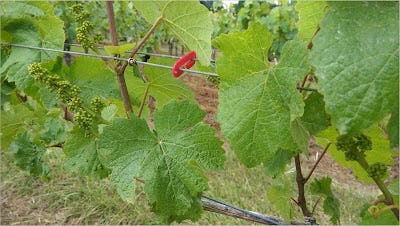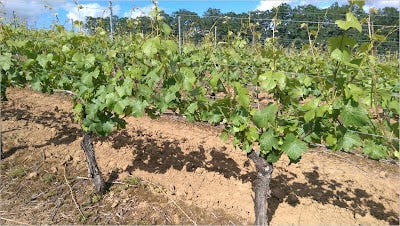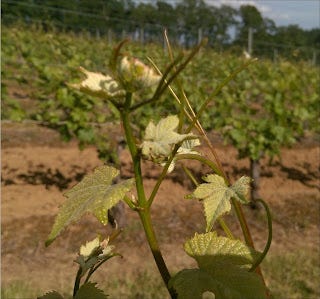Amalie Robert Estate Climate Update: 2018 May
Hello and Welcome,
This is the 2018 May Climate Update from Amalie Robert Estate. A FLOG communication.
“The future is grass. Grass, buddy.” Who remembers this quote from the movie Tequila Sunrise? Well, Ernie has been saying it with his best Raul Julia impersonation for the entire month. We have had warm sunny days combined with abundant soil moisture. The grass does not let these conditions go unnoticed. The result was a grass uprising!

The flail mower is a wonderful thing. It is a specialized piece of farm equipment that only does one thing. But it does it really well. And that is to cut a 5 foot wide swath of grass, buddy. And since our vineyard rows are 7.5 feet apart, a 5 foot cut is ideal. As we have proven in a previous post, and Ernie has the empirical evidence to back it up, one pass through the vineyard is about 20 lineal miles – at 3 miles per hour.
Mathematically, this is about 7 hours worth of farming. Farming, by the way, is what you are doing when you are not growing wine. But it’s not 7 hours, It’s more like 10 to 12 hours, and that’s if you can make whatever repairs are needed without leaving the farm for parts. And you have had the forethought to order sufficient diesel to perform said farming. And they deliver once a week – how convenient!
Ernie has made three mowing passes to cut down this grass uprising, and there will be another 3 passes once he starts hedging. That’s a lotta grass, buddy.
And the sock monster has claimed a pair (nonmatching mind you) of socks. We have yet to receive a ransom note, but that should be coming along any day now. In the mean time, this leaves us with a pair of hunting socks. Because we are hunting for the pair that looks just like them!
We have begun training our vines’ newfound Spring growth into the trellis. After just about 20 years of this activity, you would think the vines would have it figured out by now. Not so. They seem to have a classic failing, which we have seen in our previous careers. They lack focus and attention to detail.

But their rate of growth is just astounding! And if you look at it from their perspective, would you want to be constrained in 3 sets of catch wires pinched together with a few plastic clips? Confining your growth to a vertical wall of leaves about 6 inches deep and 60 inches tall to maximize sun exposure and minimize the chance of your wine berries inflicted with mildew or other fungi?
The correct answer is YES! Yes, I want that! But alas, they do not.

If given the chance, they would just grow along the ground like some nondescript ubiquitous vine until they happen upon some unsuspecting tree. Then they would grab on with their tendrils and start growing up the trunk. Meanwhile the wine berries would be on the ground, compromised by some mildew colony where they would rot and meet their unworthy demise. Surely better to be trellised, plucked by hand and then fermented into wine!

Field work is hard, physically demanding work. Field labor is tight at this particular point in history. We can’t tell if there is more agricultural work to be done due to increased acreage under cultivation or there are fewer field workers to do the work. Most likely a bit of both. And it gives us the opportunity to review the law of supply and demand, in situ.
The vines however, are unburdened by this reality. They are just growing and growing and growing. They have forgotten all about the hedger. But Ernie hasn’t. He has dreams about arresting their unbridled growth. It should be just about the end of June, or maybe the start of July. But their day is coming in the form of 10 blades spinning at a bazillion miles per hour. And the flail mower will be hooked on the back mulching the vine cuttings with all that grass, buddy.
An acre of vines at Amalie Robert Estate can be thought of as 5,808 lineal feet. This means if we put all of our vines in one row, an acre’s worth of vines would be 5,808 feet long. If you were to walk a mile that would be 5,280 lineal feet. So, logically, an acre of vines can be thought of as 1.1 miles long. If it helps, bear in mind that a vineyard is just a physical implementation of a mental construct. But the field work is real.
To put this viticultural activity in perspective, we are going to do some farming math. You most likely won’t need your thinking cap, but if it is nearby this would be the time to grab it as you refill your wine glass - even if you must open another bottle to do so.

Now each acre of vines is bedangled with 3 sets of catch wires for a total of 6 wires per acre. These catch wires do the hard work for holding our vines in place so Ernie can go out there and hedge them down to size – repeatedly. Right, so that is 6.6 miles of manually raised catch wires per acre. Note: These wires must also be taken down at the end of the year, but that is too much math to do all at once, and we don’t want anyone’s head to explode. Duct tape can help with that, by the way.
Since we rely on hard working field workers to raise these wires and position the vines’ growth inside of them, this process takes a while. Depending on a wide range of factors that would make your head explode, the average time it takes to put up 3 sets of catch wires is just about 2.5 minutes per vine, based on a 10 year average. Since we have 1,452 vines per acre, that takes us about 3,630 minutes per acre, or about 7.5 field worker days. Pretty easy so far, right?
Now we reveal the magic number: 35.74. That is the number of acres of vines we farm. Using the magic number, we can learn that we have 235.88 miles of wires to raise (and eventually lower.) We can also know that we need about 268 field worker days to raise these wires and harness the vines’ growth. So if you come to visit the winery during the month of June and Ernie asks if you want to take a walk in the vines, now you know what you are really signing up for. As always, you will want to wear comfortable shoes and gloves might be a good idea.
What we cannot know is how many field workers we will have on any given day. Which leads us to not knowing what day the wires will be raised and Ernie can start hedging. Switching from Thinking Cap to Duct Tape, buddy.
And lo and behold we have EVEN MORE numbers! Ernie guessed the rainfall amount from the last day of May would be 0.30 inches. But when Dena checked the rain gauge, she said it was 0.28 inches. Clearly it’s time for Dena’s annual eye exam.
And we have accumulated 282.2 degree days for the month of May. When added to our April degree days of 110.1, this yields 392.3 degree days for the 2018 growing season. The high temperature for the month of May was 93.0 degrees Fahrenheit and the low temperature was 37.2 degrees. A fine start to the year.

Rainfall for the month of May was 0.53 inches if you ask Dena, or 0.55 inches if you ask Ernie. The growing season to date rainfall as collected from April through May is 6.33 inches, more or less.
Kindest Regards,
Dena & Ernie



